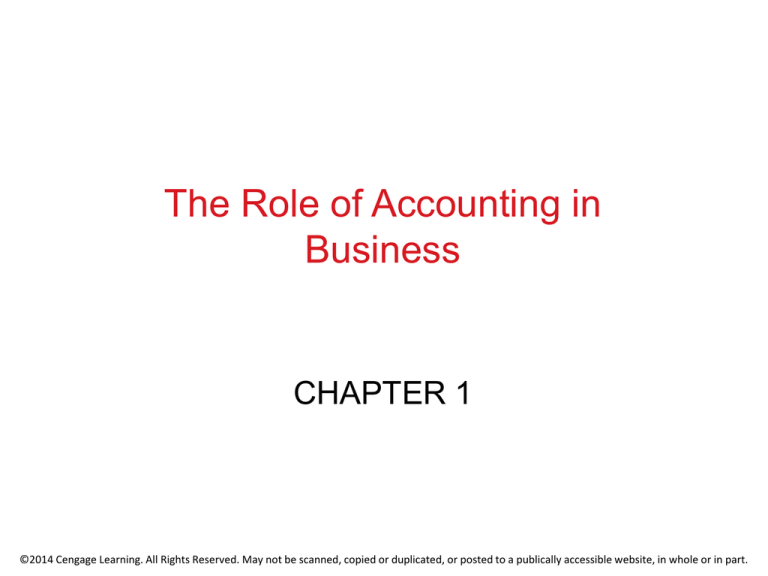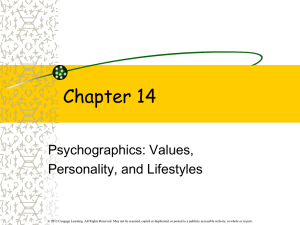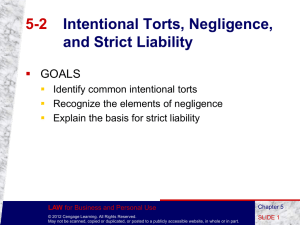
The Role of Accounting in
Business
CHAPTER 1
©2014 Cengage Learning. All Rights Reserved. May not be scanned, copied or duplicated, or posted to a publically accessible website, in whole or in part.
Learning Objectives
After studying this chapter, you should be able to:
•Describe the types and forms of businesses, how
businesses make money, and business stakeholders
•Describe the three business activities of financing,
investing, and operating
•Define accounting and describe its role in business
•Describe and illustrate the basic financial statements
and how they interrelate
•Describe eight accounting concepts underlying
financial reporting
•Financial Analysis: Describe and illustrate how the
rate of return on assets can be used to analyze and
assess a company’s financial performance
©2014 Cengage Learning. All Rights Reserved. May not be scanned, copied or duplicated, or posted to a publically accessible website, in whole or in part.
Learning Objective 1
Describe the types and forms of
businesses, how businesses make
money, and business stakeholders
©2014 Cengage Learning. All Rights Reserved. May not be scanned, copied or duplicated, or posted to a publically accessible website, in whole or in part.
Types of Businesses
_____ businesses provide services rather than products to
customers.
Delta Air Lines (transportation services)
The Walt Disney Company (entertainment services)
_____ businesses sell products they purchase from other
businesses to customers.
Walmart (general merchandise)
Amazon.com (books, music, videos)
_____ businesses change basic inputs into products that
are sold to customers.
General Motors Corporation (cars, trucks, vans)
Dell Inc. (personal computers)
©2014 Cengage Learning. All Rights Reserved. May not be scanned, copied or duplicated, or posted to a publically accessible website, in whole or in part.
Forms of Business
•
•
•
•
__________
__________
__________
__________
©2014 Cengage Learning. All Rights Reserved. May not be scanned, copied or duplicated, or posted to a publically accessible website, in whole or in part.
Differences in Forms of Business
Organizational
Form
Ease of
Formation
Legal
Liability
Taxation
Limitation
on Life of
Entity
Proprietorship
Simple
_________
_________
Yes
__________
Partnership
Simple
_________
_________
Yes
__________
Corporation
Complex
_________
_________
No
__________
Limited Liability
Company
Moderate
_________
_________
Yes
__________
Access to
Capital
©2014 Cengage Learning. All Rights Reserved. May not be scanned, copied or duplicated, or posted to a publically accessible website, in whole or in part.
How do Businesses Make Money?
• By providing goods and services to customers
so that they can make a _____
• To maximize their profits, companies may use
one of the following two strategies:
• __________
• __________
©2014 Cengage Learning. All Rights Reserved. May not be scanned, copied or duplicated, or posted to a publically accessible website, in whole or in part.
How do Businesses Make Money?
©2014 Cengage Learning. All Rights Reserved. May not be scanned, copied or duplicated, or posted to a publically accessible website, in whole or in part.
Business Stakeholders
Business Stakeholder
Interest in the Business
Examples
____________
Providers of major financing
for the business
Banks, owners,
stockholders
_____________
Buyers of products or services
and vendors to the business
Customers and suppliers
______________
Collect taxes and fees from the
business and its employees
Federal, state, and city
governments
______________
Individual employed by the
business
Employees and
managers
©2014 Cengage Learning. All Rights Reserved. May not be scanned, copied or duplicated, or posted to a publically accessible website, in whole or in part.
Business Stakeholders
©2014 Cengage Learning. All Rights Reserved. May not be scanned, copied or duplicated, or posted to a publically accessible website, in whole or in part.
Learning Objective 2
Describe the three business activities of
financing, investing, and operating
©2014 Cengage Learning. All Rights Reserved. May not be scanned, copied or duplicated, or posted to a publically accessible website, in whole or in part.
Business Activities
• _______________
_______________
• _______________
_______________
• _______________
_______________
_______________
_______________
• _______________
_______________
• ______________
_______________
©2014 Cengage Learning. All Rights Reserved. May not be scanned, copied or duplicated, or posted to a publically accessible website, in whole or in part.
Learning Objective 3
Define accounting and describe its role in
business
©2014 Cengage Learning. All Rights Reserved. May not be scanned, copied or duplicated, or posted to a publically accessible website, in whole or in part.
Objectives of Financial Accounting
• Sometimes called the “___________________”,
accounting is an information system that
provides reports to stakeholders about the
economic activities and condition of a business
• Essentially, it summarizes the financial
performance of the firm for external users
• The two major objectives of financial accounting
are:
• To report the financial condition of a business at a
point in time
• To report changes in the financial condition of a
business over a period of time
©2014 Cengage Learning. All Rights Reserved. May not be scanned, copied or duplicated, or posted to a publically accessible website, in whole or in part.
Two Major Objectives of
Financial Accounting
Financial Condition
As at a _____
__________
Financial Condition
Over a _____
__________
©2014 Cengage Learning. All Rights Reserved. May not be scanned, copied or duplicated, or posted to a publically accessible website, in whole or in part.
Learning Objective 4
Describe and illustrate the basic financial
statements and how they interrelate
©2014 Cengage Learning. All Rights Reserved. May not be scanned, copied or duplicated, or posted to a publically accessible website, in whole or in part.
Financial Statements
•
•
•
•
______________________
______________________
______________________
______________________
©2014 Cengage Learning. All Rights Reserved. May not be scanned, copied or duplicated, or posted to a publically accessible website, in whole or in part.
Income Statement
• Summary of revenue and expenses for a specific period
of time (e.g., month, quarter, or year)
• Reports the change in financial condition due to the
operations of a business
• Uses the _____ concept: Expenses for the period are
matched against revenues for the same period
_____________ – ___________ =
________________
©2014 Cengage Learning. All Rights Reserved. May not be scanned, copied or duplicated, or posted to a publically accessible website, in whole or in part.
Retained Earnings Statement
• Reports changes in financial condition due to changes in
retained earnings during a period
• Retained earnings is the portion of ________ retained by
the business
©2014 Cengage Learning. All Rights Reserved. May not be scanned, copied or duplicated, or posted to a publically accessible website, in whole or in part.
Balance Sheet
• Reports financial condition at a point in time
• Measured by total assets and claims to those assets:
_________ = ____________ + _________
©2014 Cengage Learning. All Rights Reserved. May not be scanned, copied or duplicated, or posted to a publically accessible website, in whole or in part.
Balance Sheet – Preparation
• Step 1:
• Step 2:
• Step 3:
• Step 4:
• Step 5:
Each asset is listed and added to arrive at
total assets
Each liability is listed and added to arrive at
total liabilities
Each stockholders’ equity item is listed and
added to arrive at total stockholders’ equity
Total liabilities and total stockholder’s equity
are added together
__________ must equal total liabilities and
stockholders’ equity
©2014 Cengage Learning. All Rights Reserved. May not be scanned, copied or duplicated, or posted to a publically accessible website, in whole or in part.
Statement of Cash Flows
•
Reports the change in financial condition due to the changes in cash
during a period
— Net change in operating cash flows
— Net change in investing cash flows
— Net change in financing cash flows
©2014 Cengage Learning. All Rights Reserved. May not be scanned, copied or duplicated, or posted to a publically accessible website, in whole or in part.
Statement of Cash Flows –
Operating Activities
• Net cash flows from operating activities is reported
first
• Cash flow from operating activities is a focus of
stakeholders
• Operating activities are transactions that involve the
acquisition or production of products and services
and the sale of those products or services to
customers
©2014 Cengage Learning. All Rights Reserved. May not be scanned, copied or duplicated, or posted to a publically accessible website, in whole or in part.
Statement of Cash Flows –
Investing Activities
• Net cash flows from investing activities is reported
second
• Cash receipts from selling property, plant, and
equipment are reported in this section
• Cash used to purchase property, plant, and
equipment is also reported in this section
• Negative cash flow from investing activities is
normal for an expanding company
©2014 Cengage Learning. All Rights Reserved. May not be scanned, copied or duplicated, or posted to a publically accessible website, in whole or in part.
Statement of Cash Flows –
Financing Activities
• Net cash flows from financing activities is reported
third
• Any cash receipts from issuing debt or stock are
reported in this section
• Cash payments on debt and dividends are also
reported in this section
©2014 Cengage Learning. All Rights Reserved. May not be scanned, copied or duplicated, or posted to a publically accessible website, in whole or in part.
Integrated Financial Statements
©2014 Cengage Learning. All Rights Reserved. May not be scanned, copied or duplicated, or posted to a publically accessible website, in whole or in part.
Integrated Financial Statements
• Net income from the income statement is linked to
the ____________
• Retained earnings is linked to the stockholders’
equity in the ____________
• Cash balance from the ____________ is linked to
cash in the balance sheet
©2014 Cengage Learning. All Rights Reserved. May not be scanned, copied or duplicated, or posted to a publically accessible website, in whole or in part.
Learning Objective 5
Describe eight accounting concepts
underlying financial reporting
©2014 Cengage Learning. All Rights Reserved. May not be scanned, copied or duplicated, or posted to a publically accessible website, in whole or in part.
The Accounting “Rules”
GAAP - G_____ A_____ A_____
P_____
©2014 Cengage Learning. All Rights Reserved. May not be scanned, copied or duplicated, or posted to a publically accessible website, in whole or in part.
Eight Accounting Concepts
©2014 Cengage Learning. All Rights Reserved. May not be scanned, copied or duplicated, or posted to a publically accessible website, in whole or in part.
Financial History of a Company
©2014 Cengage Learning. All Rights Reserved. May not be scanned, copied or duplicated, or posted to a publically accessible website, in whole or in part.
Accounting Frauds
©2014 Cengage Learning. All Rights Reserved. May not be scanned, copied or duplicated, or posted to a publically accessible website, in whole or in part.
Guidelines for Ethical Conduct
©2014 Cengage Learning. All Rights Reserved. May not be scanned, copied or duplicated, or posted to a publically accessible website, in whole or in part.
Learning Objective 6
Financial Analysis: Describe and illustrate
how the rate of return on assets can be
used to analyze and assess a company’s
financial performance
©2014 Cengage Learning. All Rights Reserved. May not be scanned, copied or duplicated, or posted to a publically accessible website, in whole or in part.
Rate of Return on Assets
• A measure of a company’s profitability
Rate of Return
on Assets
___ ____ ____ ___ ___ ____ _____
=
_____ _____ ______
• Expressed as a percentage or as an amount per
dollar invested
• For example: a 12% rate of return on assets
could also be expressed as $0.12 return per $1
invested
©2014 Cengage Learning. All Rights Reserved. May not be scanned, copied or duplicated, or posted to a publically accessible website, in whole or in part.
Rate of Return on Assets
• Apple is 3.8 (38.1% 4 10.7%) times more profitable than Dell
Inc.
©2014 Cengage Learning. All Rights Reserved. May not be scanned, copied or duplicated, or posted to a publically accessible website, in whole or in part.
End of Chapter 1
©2014 Cengage Learning. All Rights Reserved. May not be scanned, copied or duplicated, or posted to a publically accessible website, in whole or in part.








